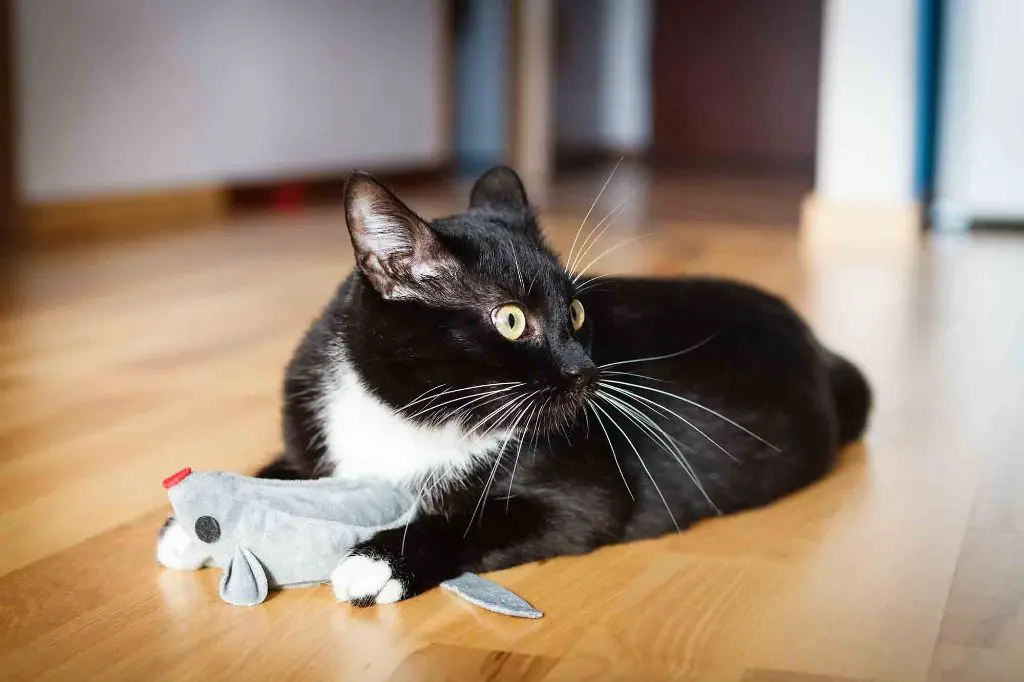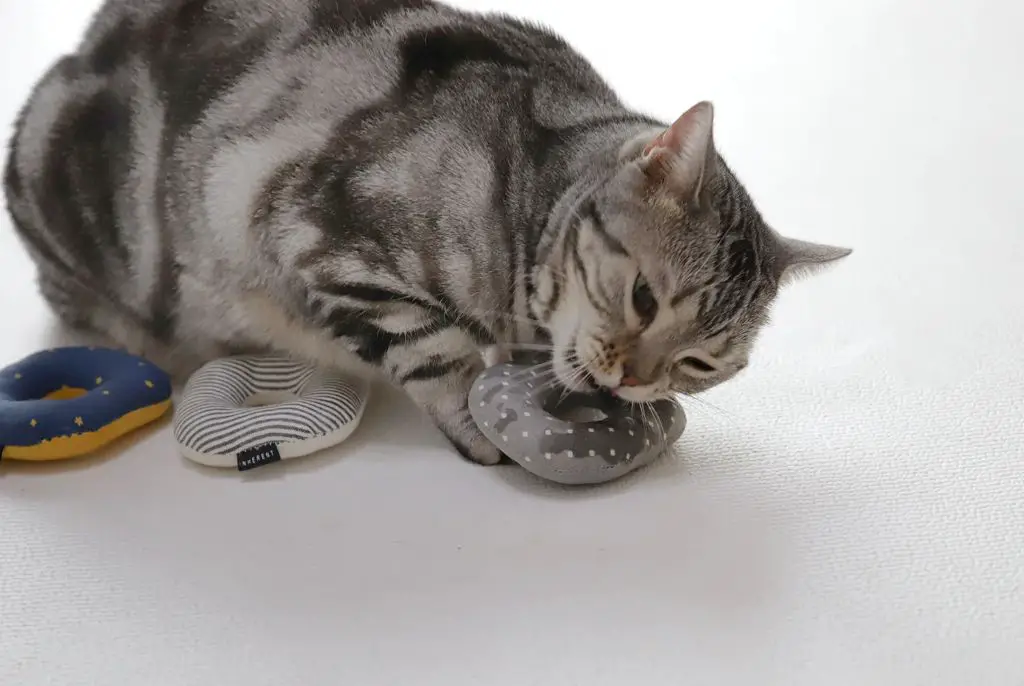Catnip is a minty herb from the Nepeta cataria plant that has a strong effect on cats and some other felines. The active ingredient in catnip, called nepetalactone, causes a euphoric reaction when cats smell or ingest the herb. Although the exact mechanism is not well understood, catnip seems to stimulate receptors in a cat’s brain and nervous system, leading to behaviors including rubbing, rolling, head shaking, and playfulness. In essence, catnip makes cats temporarily giddy and excitable. The high normally lasts around 10 minutes before wearing off. Not all cats are affected by catnip – around 20-30% do not respond to it. For those that do, catnip provides a harmless and enjoyable experience. This article will explore what happens when you spray catnip on cats, from the initial behavioral response to the after-effects.
Olfactory Response
Catnip contains an essential oil called nepetalactone which binds to olfactory receptors in a cat’s nose and activates a response (Hart, 1985). When a cat inhales the scent of catnip, the nepetalactone molecules bind to receptors in the olfactory epithelium inside their nasal cavity, which then sends signals to the olfactory bulb region of the brain (Hart, 1985).

The olfactory bulb further processes the signals and transmits them to other parts of the brain like the amygdala and hypothalamus, which are involved in regulating emotions and behaviors (Scientific American, 2007). This input from catnip activates the amygdala and hypothalamus to produce the characteristic euphoric response like rolling, rubbing, head shaking and stretching that is observed when cats smell catnip (Hart, 1988).
Research suggests catnip does not activate the vomeronasal organ, only the main olfactory system, indicating the response is purely based on scent and not pheromones (Hart, 1985). Overall, catnip elicits both neurological and physical responses through its interaction with olfactory receptors and downstream signaling to processing centers in the cat’s brain.
Neurological Effects
Catnip contains nepetalactone, a volatile oil that activates certain receptors in a cat’s brain and triggers a stimulant-like response. When cats smell nepetalactone, it binds to olfactory receptors and stimulates neurons that produce dopamine and activate the brain’s “reward system” (Scientific American). This flood of dopamine induces a temporary euphoric state, similar to how humans can feel high after indulging in something pleasurable.
The neurological effects can make cats act noticeably different for around 5-15 minutes after exposure to catnip. Their pupils may dilate, and they may start rubbing, rolling, licking, or even eating the catnip. Some cats vocalize more while under the influence. Increased playfulness, jumping, pouncing, and hunting behaviors are also common reactions. These hyperactive responses are all linked to catnip’s stimulant activity in the brain (Vox).
However, the reactions are usually harmless and temporary. Catnip does not appear to have serious drug-like effects that could harm the brain with extended use (Intermountain Pet Hospital). After the initial response, cats typically lose interest in catnip for at least an hour until the brain’s receptors are ready to be activated again.
Physical Reactions

Catnip causes a variety of physical reactions in cats. The most common physical reactions include:
- Rolling around – Cats will often roll back and forth on their backs after smelling catnip.
- Rubbing – Cats rub up against surfaces like walls after exposure to catnip.
- Scratching – Scratching furniture and rubbing their face against things are common reactions.
- Jumping – Some cats become more playful and energetic, jumping up walls and furniture.
- Vocalizing – Cats may meow, growl or make other vocalizations when on catnip.
- Kneading – Cats display kneading behavior with their front paws while under the influence of catnip.
- Chewing – Chewing on catnip toys or plants is common as they try to consume more.
- Lethargy – After an initial activation period, some cats become more relaxed and lethargic from catnip.
These physical reactions typically last between 5 to 15 minutes after exposure before returning to normal. The strength of the reaction depends on the individual cat.
Duration of Effects
The effects of catnip typically last around 10-15 minutes on most cats before wearing off (1). Once the initial catnip response has ended, it may take 30 minutes to an hour before the cat can experience the effects again (2). The active chemical in catnip, called nepetalactone, binds to olfactory receptors in a cat’s nose which triggers the characteristic response. However, the cat soon becomes desensitized to the chemical after several minutes. The receptors essentially become fatigued and stop responding, leading to the short duration of action (1).

Luckily, catnip does not seem to be addictive or habit-forming for cats. The temporary desensitization prevents them from continually seeking out the plant. Responsible cat owners can utilize catnip as an occasional treat without risk of long-term issues. However, it’s best not to expose cats to catnip multiple times per day, as this can lead to overstimulation and agitation (3). Overall, catnip provides a temporary high for cats to enjoy, with effects dissipating within about 15 minutes so they can return to normal.
Sources:
(1) https://www.petmd.com/cat/general-health/what-is-catnip
(2) https://www.smalldoorvet.com/learning-center/medical/catnip/
(3) https://www.beverlyhillsvets.com/blog/effects-of-catnip/
Repeated Exposure
Research shows that repeated exposure to catnip does not reduce its effects on cats. Cats can experience the euphoric effects of catnip multiple times a day without building a tolerance. According to PetMD, cats cannot develop an addiction or dependence on catnip, as the chemical compound nepetalactone binds to receptors in the cat’s nose and does not cause long-term changes in the brain like addictive drugs. The effects of catnip wear off quickly, and according to Texas A&M, after 10-20 minutes, cats are back to normal and ready to be “catnip high” again if exposed to more.
Catnip vs. Other Plants
While catnip is the most well-known plant that induces a euphoric reaction in cats, there are other plants that can have similar effects. Two notable alternatives to catnip are silver vine and valerian root.
Silver vine contains compounds called actinidine that mimic the effects of nepetalactone in catnip. Studies have shown that some cats who do not respond to catnip will react to silver vine. The reaction appears very similar to catnip, inducing playfulness, rubbing, and rolling around. Silver vine can be purchased in toys and treats, providing an alternative for cats unaffected by catnip (https://bmcvetres.biomedcentral.com/articles/10.1186/s12917-017-0987-6).
Valerian root contains the compound actinidine, which is chemically similar to nepetalactone in catnip. Valerian root induces a more subdued reaction than catnip or silver vine, but some cats do respond by sniffing, licking, and chewing the herb. It produces a mild sedative effect rather than energetic playfulness. Valerian can be tried for cats that do not respond to other herbs (https://www.dvm360.com/view/olfactory-enrichment-for-cats-alternatives-to-catnip).
Both silver vine and valerian root present alternatives to try for cats unaffected by catnip. However, catnip remains the most popular and potent herbal stimulant for the majority of domestic cats.
Safety
Catnip is widely considered to be a completely safe and non-addictive substance for cats. There is no evidence that cats can become dependent on or addicted to catnip.
Cats cannot fatally overdose on catnip. Consuming large amounts may cause temporary gastrointestinal upset like vomiting or diarrhea, but serious toxicity is extremely unlikely.
Responsible cat owners can feel secure giving their cats catnip, even on a regular basis. It does not function as an addictive drug for cats like opioids do in humans. Instead, it is more akin to safe sensory enrichment.
Some cats may enthusiastically seek out catnip, but this enthusiasm diminishes with repeated exposure in a short period of time. It does not continually intensify. For this reason, catnip is widely regarded as non-habit forming and safe.
Other Uses
Catnip has a variety of uses beyond its appeal to cats.
Since catnip contains nepetalactone, the essential oil that causes the response in cats, it can act as a natural insect repellent against mosquitos, cockroaches, and ticks when used by people. Catnip essential oil or leaves can be used to create homemade bug sprays. According to Gardening Know How, catnip planted around the home can help deter spiders, cockroaches, and mosquitos from entering.
Catnip can also be consumed by people as a herbal tea. The tea has a minty, zesty taste and contains chemicals that promote relaxation. Some people drink catnip tea for its soothing effects or to aid with anxiety, insomnia, and digestive issues. According to Common Sense Home, catnip tea was traditionally used to relieve menstrual cramps and induce sweating during fevers.
In addition to repelling insects and making tea, catnip is sometimes used in cooking, as a garden ornamental plant, and even as cat toys or training tools due to cats’ fondness for the smell.
Conclusion

In summary, when catnip is sprayed on cats, it triggers an interesting and mostly harmless reaction. Cats have an inherited sensitivity to compounds found in catnip that bind to receptors in their noses and trigger neurological effects. These effects include rolling around, pawing at their surroundings, rubbing, facial marking, and ignoring their owners. The effects peak after 5-15 minutes and last around 30 minutes in total before wearing off. With repeated exposure, some cats may become less responsive. While strange to witness, these reactions are not dangerous and do not have any known long-term consequences. Catnip provides a safe and natural form of sensory entertainment for domestic cats. Understanding the science behind this unique plant helps owners appreciate yet another one of their cat’s quirky behaviors.

